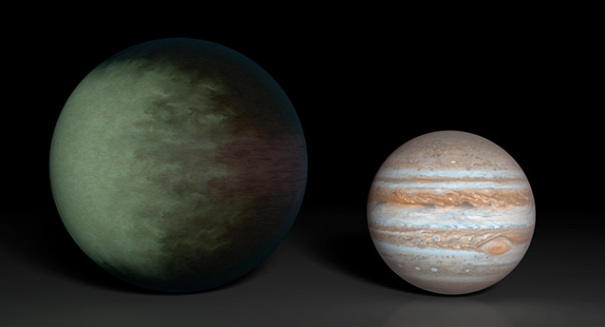
Kepler has reportedly found more than 150 exoplanets and Kepler-7b was one of the first.
According to a press release from NASA’s Jet Propulsion Laboratory, the space agency’s Kepler and Spitzer space telescopes have discovered patchy clouds on an exotic world. Their discovery has led to the first cloud map of Kepler-7b, a piping hot, Jupiter-like exoplanet.
The planet is distinguished by high clouds in the west and clear skies in the east. Previous research from Spitzer has produced temperature maps of planets circling other stars, but this is the first glimpse at cloud structures on a far-off planet.
“By observing this planet with Spitzer and Kepler for more than three years, we were able to produce a very low-resolution ‘map’ of this giant, gaseous planet,” said lead author Brice-Olivier Demory of Massachusetts Institute of Technology. “We wouldn’t expect to see oceans or continents on this type of world, but we detected a clear, reflective signature that we interpreted as clouds.”
Kepler has reportedly found more than 150 exoplanets and Kepler-7b was one of the first. Though Kepler is no longer looking for exoplanets, astronomers have four years’ worth of data to examine.
Kepler’s visible-light observations of Kepler-7b’s phases resulted in an unfinished map of the planet that revealed a shining spot on its western hemisphere. However, the data did not allow astronomers to determine whether the shining spots was originating from clouds or heat. Enter Spitzer.
Spitzer’s capability to identify infrared light means that it was able to determine Kepler-7b’s temperature, approximating it to between 1,500 and 1,800 degrees Fahrenheit. Amazingly, this is somewhat cool for a planet that circles so close its star and too cool to be the origin of light Kepler detected. Instead, researchers discovered that light from the planet’s star is glancing off cloud tops found on the west side of the planet.
“Kepler-7b reflects much more light than most giant planets we’ve found, which we attribute to clouds in the upper atmosphere,” said Thomas Barclay, Kepler scientist at NASA’s Ames Research Center. “Unlike those on Earth, the cloud patterns on this planet do not seem to change much over time — it has a remarkably stable climate.”
The discovery is reportedly the first step toward utilizing similar methods to examine the atmospheres of planets more like Earth in both makeup and size.
“With Spitzer and Kepler together, we have a multi-wavelength tool for getting a good look at planets that are trillions of miles away,” said Paul Hertz, director of NASA’s Astrophysics Division. “We’re at a point now in exoplanet science where we are moving beyond just detecting exoplanets, and into the exciting science of understanding them.”
The study’s findings will be discussed in the Astrophysical Journal Letters.
Leave a Reply